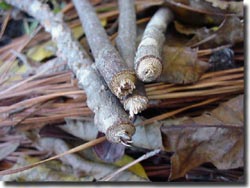Twig Girdler
One interesting aspect of my job as a horticultural extension agent is the bug questions and samples I get to see. Just last week, a client brought in a photo of a Tramea onusta, a red saddlebags dragonfly. Another client sent a photo of a tomato hornworm. Some of the photos have beautiful and interesting bugs, but usually the questions focus on insects that are causing problems.
Over the last few weeks, I have received several phone calls from homeowners who have small tree limbs that look like they’ve been cut off. The clients describe a blunt cut that might be made with pruning shears or a small saw on limbs the size of pencils or a finger. This is not the work of pranksters! The trees have been visited by the twig girdler beetle!
Twig girdler beetles in our area are the pecan twig girdler, Oncideres pustulatas LeConte, which attack citrus, elm, hackberry, hickory, huisache, mimosa, pecan, persimmon, red oak, retama, Texas ebony, walnut, and various fruit trees. They are ½ to ¾ inch long, light to dark brown with a wide gray band across the wing covers, pink, orange, or yellow spots, and long antennae.
During the fall, usually September through November, the twig girdler reaches adulthood and mates. The female twig girdler will lay her eggs on a small branch, then she chews around the branch forming a notch, much like a beaver would. The twig usually breaks free and falls to the ground or it might hang loosely. The eggs hatch in about three weeks and feed on the cut branch. Twig girdlers have one generation per year and the adults usually live six to ten weeks.
The twig girdler beetle does not do serious harm to the tree; they are mostly a nuisance. Chemical control is not recommended in a home lawn. The branches that fall from a twig girdler’s work should be collected and destroyed because the eggs are living inside the branch. The beetles are not commonly found on trees.




